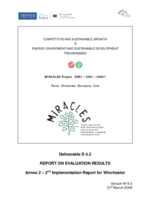Vehicle emissions testing
Summary
Vehicles were monitored as they entered the city centre along the main arterial roads, and an automatic number plate recognition system was linked to the newly procured remote sensing equipment.
Implementing sustainable mobility
Prior to the MIRACLES project, the Winchester Movement and Access Plan had successfully developed the Clear Zones initiative in order to reduce emissions in the city centre.
In September 2003, Winchester City Council issued a statutory declaration of an air quality management area the city centre, due to the city’s unacceptable levels of air pollution, and the Air Quality Action Plan was developed. MIRACLES contributed significantly to the development of the action plan, which incorporated many of the MIRACLES measures.
This measure enabled so-called gross polluters to be directly targeted and strategies to be developed aimed at achieving emissions reductions.
Progress
Innovative equipment, originally developed under the EU REVEAL project, was procured and modified to include the monitoring of vehicle speed and acceleration and improve portability. This was linked to an automatic number plate recognition system and a mobile variable message sign (VMS) to be used at the roadside in order to identify and then inform individual polluters of their emissions.
Specific test sites were identified and vehicles were monitored as they entered Winchester along main arterial routes. Measurements were then compared with the United Kingdom’s Vehicle Inspectorate Ministry of Transport (MOT) test standards to define a cut-off point for gross polluters.
A four-stage enforcement strategy was designed to encourage voluntary maintenance of high-polluting vehicles and to restrict their access to the city-centre air quality management area:
- the use of a mobile VMS at the roadside to inform drivers of their emission levels (i.e. good, fair or poor);
- the use of a database of emissions readings from individual vehicles;
- the provision of a subsidised emissions check and repair service for highly polluting vehicles; and
- the diversion of highly polluting vehicles towards park and ride facilities in order to prevent them entering the city centre.
A database of vehicle information was built up from the readings and used to assess the likely impacts of the various enforcement strategies.
Outcomes
The percentage of monitored vehicles that could be classed as high polluters was very small (approximately 0.1 percent for carbon monoxide; 0.4 percent for hyrdrocarbon; and 0.01 percent for nitrogen oxide). With fewer high polluters than originally anticipated, the planned practical evaluation of the feedback was replaced by a detailed, stated preference survey and MIRACLES questionnaires.
Results indicated that regular feedback to vehicle owners on their emissions would be welcomed: 80 percent agreed with the monitoring of vehicles to reduce pollution; 73 percent wished to be informed of their vehicle’s emissions; 80 percent would have their vehicle’s engine checked if a VMS indicated that the vehicle’s emissions came into the category “poor”; 76 percent would be interested in a subsidy if their vehicle was suspected of having an emissions fault; 72 percent agreed that suspected high polluters should be encouraged to use park and ride facilities; between 13 and 23 percent indicated that they would divert to park and ride facilities if a VMS indicated that their vehicle’s emissions level was poor; and 60 percent would make use of a web-based emissions checking service at least once a month.
Links to vehicle records held by regional or national agencies would allow the captured records to be enriched with fuel type, age and emissions standard. This would enable a more targeted approach, allowing the owners of the identified highly polluting vehicles to be contacted.








